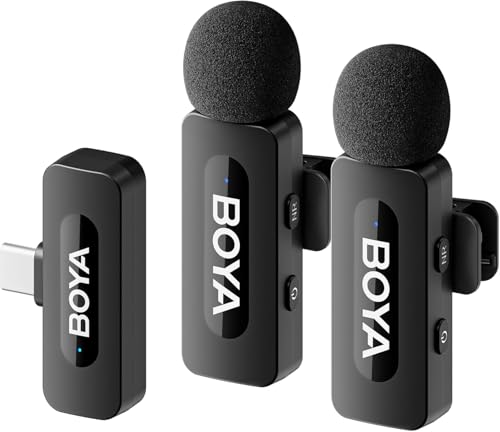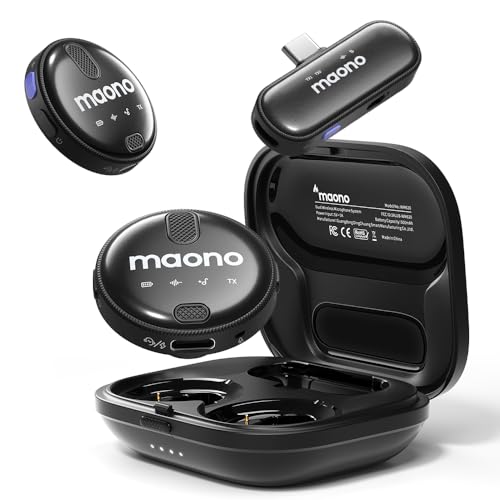- Note: If you encounter connectivity issues with any Android mobile phones, access your device settings, search for “OTG”…
- Portable Wireless Microphone: Discover the Portronics Dash 7, your portable wireless lavalier microphone. Experience smo…
- 360° Audio Sensing & Noise Cancellation: Experience superior audio recording with the built-in 360° omnidirectional pick…
Introduction
In today’s digital age, the role of microphones has evolved significantly, becoming essential tools for content creators across various platforms. Whether one is recording podcasts, creating engaging YouTube videos, or producing high-quality music, selecting the right microphone can greatly enhance the overall output. The significance of a superior microphone cannot be understated; it directly influences audio clarity, professionalism, and listener engagement, which are critical for success in any audio-related endeavor.
Choosing the appropriate microphone involves considering several factors, including type, sensitivity, and intended use. For instance, dynamic microphones are often favored in live performance settings due to their durability, while condenser microphones may be preferred for studio recordings for their sensitivity and accuracy. Furthermore, advancements in technology have led to a plethora of options available, making the selection process both exciting and daunting. It is crucial for users to understand their specific requirements and the characteristics of different microphones to make informed decisions.
This blog post aims to provide an in-depth review of three popular microphones: Boya, Maono, and Portronics. Each of these brands offers unique features and specifications catering to various needs. Boya microphones are known for their affordability and versatility, making them a popular choice among beginners and seasoned content creators alike. On the other hand, Maono microphones are celebrated for their quality and reliability, especially in the podcasting realm. Finally, Portronics impresses with its compact designs and user-friendly technology, appealing to those looking for practicality without sacrificing sound quality.
In exploring these three brands, our objective is to equip readers with insights that aid in selecting the most suitable microphone for their specific applications and provide a clear understanding of what each brand brings to the table.
Overview of Reviewed Microphones
The microphone market offers a wide array of options catering to various audio needs, and among the standout choices are the Boya BY-M1, Maono AU-A03, and Portronics Muffs-3. Each microphone serves distinct functionalities, making them suitable for aspiring content creators, podcasters, and recording professionals.
The Boya BY-M1 is a versatile lavalier microphone designed for interviews, vlogging, and video recording. It features a 6-meter cable, allowing ample distance from the device while maintaining high sound quality. The omnidirectional pickup pattern ensures that audio capture remains clear regardless of the speaker’s orientation. This microphone is compatible with smartphones, cameras, and computers, making it a reliable addition for both beginner and experienced users. Boya has built a solid reputation in the audio equipment field, emphasizing quality and affordability.
Moving on to the Maono AU-A03, this microphone is particularly favored among content creators for its user-friendly design and exceptional audio clarity. Equipped with a rechargeable battery and providing plug-and-play functionality, it accommodates various recording environments seamlessly. The cardioid pickup pattern focuses on sound sourced directly in front of the mic, effectively reducing background noise. This makes the Maono AU-A03 an excellent option for podcasting and voice-over work, thus establishing Maono as a credible player in the market.
Lastly, the Portronics Muffs-3 offers a unique alternative for those looking for a more portable microphone solution. This compact, lightweight device is tailored for mobile usage, making it perfect for field recordings and on-the-go interviews. Its noise-cancellation feature enhances clarity, ensuring high fidelity audio output regardless of external noise interference. Portronics has become known for its innovative electronic products, and the Muffs-3 exemplifies the brand’s commitment to functionality and ease of use.
Sound Quality Comparison
When evaluating microphones, sound quality stands as the most crucial aspect to consider. In this section, we will delve into the sound quality of the Boya, Maono, and Portronics microphones, focusing on clarity, frequency response, and noise cancellation capabilities.
The Boya microphone is known for its exceptional clarity. During recording sessions, its ability to capture nuanced vocal details is impressive. This microphone excels in providing a smooth frequency response, which is particularly beneficial when recording vocals or instruments. It effectively manages to balance high and low frequencies, offering a rich, full-bodied sound that resonates well in both home studio and outdoor environments. The built-in noise cancellation features work effectively to minimize unwanted background noise, allowing for a cleaner audio output.
Conversely, the Maono microphone presents a unique sound signature that caters to podcasters and content creators. Many users have found that the Maono microphone emphasizes the mid-range frequencies, making it ideal for spoken word recordings. Its noise cancellation capabilities are solid, effectively isolating the subject’s voice from ambient sounds. However, when used in environments with high levels of background noise, it may require additional audio processing to achieve a pristine output. The frequency response tends to flatter vocal tracks, making the recording experience more engaging.
The Portronics microphone, while often regarded as a budget-friendly option, surprises many with its sound quality. Although not as refined as the Boya or Maono, it still delivers satisfactory clarity for casual recordings. The frequency response ranges adequately, making it suitable for voice recording; however, it may struggle in complex sound environments. Noise cancellation is fairly average, which may pose challenges in louder settings. Overall, the Portronics microphone serves well for beginners or those who prioritize budget over absolute sound quality.
In conclusion, each microphone offers a distinct set of sound qualities that cater to different recording scenarios. The Boya stands out for its clarity, the Maono excels in spoken word applications, and the Portronics provides an affordable entry point for novice users. Careful consideration of these sound qualities will assist users in selecting the right microphone for their specific needs.
Design and Build Quality
The design and build quality of microphones significantly influence their usability and longevity. This review focuses on three noteworthy models: Boya, Maono, and Portronics, each exhibiting unique attributes in terms of aesthetics, materials, and user-friendliness.
The Boya microphone showcases a robust build, often constructed with high-quality plastic that ensures durability while remaining lightweight, making it ideal for portable use. Its sleek design is complemented by a matte finish, reducing reflections that may distract during recording. The microphone features a compact form factor, which allows for easy handling and mobility. Accessories such as a foam windshield and a sturdy mount enhance usability by providing added protection against wind noise and facilitating stable positioning.
In contrast, the Maono microphone has a minimalist aesthetic, characterized by its elegant aluminum housing. This not only enhances its overall appeal but also contributes to its sturdiness. The microphone’s weight, slightly heavier than Boya’s, gives it a premium feel during operation. Additionally, Maono often includes a pop filter and a tripod stand, which are essential accessories that enhance performance by reducing plosives and offering stable support during recording sessions.
Lastly, the Portronics microphone features a unique industrial design with a focus on user-friendly operations. Built primarily from durable plastic, it remains lightweight while ensuring resilience. The microphone is ergonomically shaped for comfortable long-term use, which is a key consideration for extended recording sessions. Included accessories such as a long cable provide flexibility in positioning, enabling users to set up their recording space effectively.
Overall, while each microphone presents distinct designs and build qualities, they all prioritize durability and usability, making them suitable options for a variety of recording needs.
Ease of Use
When evaluating the ease of use of the Boya, Maono, and Portronics microphones, several factors come into play. These include compatibility with various devices, installation process, and the intuitiveness of their controls. Each microphone offers distinct advantages in terms of usability, catering to a range of users from novices to seasoned professionals.
The Boya microphone is particularly known for its broad compatibility, allowing seamless integration with cameras, computers, and mobile phones. The installation process is straightforward; users simply need to plug it into the appropriate port without requiring additional software or complicated setups. This feature enhances its appeal among users who prioritize a quick and hassle-free microphone setup. The controls on the Boya are also user-friendly, ensuring that even those with minimal technical expertise can operate it effectively.
In contrast, the Maono microphone brings its own merits to the table. It is generally easy to install and set up, with clear instructions provided. The Maono offers USB connectivity, which makes it compatible with a wide array of devices. Users will find that the microphone comes with customizable settings, adding a layer of control while still remaining intuitive. However, some users have reported a slightly steeper learning curve due to the various features available, which may appear overwhelming initially. Nonetheless, many find that the quality gained from these features is worth the effort.
The Portronics microphone shines in its portability and ease of use. It is lightweight and designed for on-the-go recording, making it an ideal choice for mobile users. The installation process is almost instantaneous, and it pairs effortlessly with smartphones and laptops. Users have praised its simple interface, allowing for easy adjustment of settings while recording. Overall, the Portronics microphone is tailored for those who seek convenience without sacrificing audio quality.
Performance in Different Environments
The performance of microphones can vary significantly based on their environment, and this assessment delves into the capabilities of the Boya, Maono, and Portronics microphones under diverse conditions. Understanding how these microphones handle distinct soundscapes is crucial for users seeking reliable audio capture across various scenarios.
Starting with the Boya microphone, it demonstrates commendable performance in quiet indoor settings, producing clear audio with minimal background noise. The cardioid pattern effectively isolates the speaker’s voice, making it suitable for podcasts and voiceovers. However, in noisy environments, such as crowded events or public spaces, the Boya microphone faces challenges. Despite its noise-canceling features, some ambient sounds may still seep through, potentially affecting audio clarity.
In contrast, the Maono microphone excels in diverse conditions, particularly in noisy environments. Thanks to its advanced noise reduction technology and windscreen, it captures voice with impressive clarity while minimizing surrounding disturbances. This feature makes the Maono notably advantageous for outdoor recording sessions, where wind and background chatter could compromise audio integrity. When tested in a busy café, the microphone maintained focus on the speaker without excessive distortion from surrounding noise.
On the other hand, the Portronics microphone showcases versatility in both quiet and outdoor environments. While its performance in indoor settings is solid, it is the outdoor applications that reveal its strengths. Equipped with a robust windscreen and adaptive sound technology, the Portronics microphone effectively mitigates wind noise, allowing clear recording during hikes or outdoor interviews. Certain users have noted its reliability and performance during varied weather conditions, which is particularly noteworthy for content creators working outside.
Ultimately, each microphone offers unique advantages based on the specific contexts in which they are utilized. Evaluating their performance across different environments aids potential users in selecting the most suitable option for their recording needs.
Price and Value for Money
The evaluation of price and value for money in the context of microphones involves an intricate balance between cost, features, and performance. The Boya microphone is commonly priced in the mid-range segment, providing a solid entry-level choice for those who prioritize affordability without compromising too much on sound quality. With its clear audio reproduction and user-friendly design, it delivers commendable performance for podcasting and vlogging enthusiasts. This positions Boya as a viable option for budget-conscious consumers seeking decent sound quality for less.
On the other hand, the Maono microphone often emerges as a slightly higher-priced option in this comparison. It offers an impressive array of features, including built-in sound monitoring and adjustable gain settings. This enhanced functionality, in conjunction with high-definition audio capture, justifies the higher price tag. Customers will find that Maono provides a balance between affordable pricing and professional-quality output, making it a suitable consideration for aspiring content creators who are willing to invest a little more for superior performance.
Lastly, the Portronics microphone rounds out this analysis with its unique selling points. Generally falling on the lower end of the price spectrum, Portronics emphasizes portability and convenience without sacrificing audio quality. While some might see the budget price as a potential trade-off, its durability and satisfactory sound performance suggest that it, too, offers good value for money. Users will appreciate the practicality this device brings, particularly when on the go.
In conclusion, when assessing the price and value for money of the Boya, Maono, and Portronics microphones, it is evident that each offers distinctive benefits aligned with different user needs. Careful consideration of sound quality, durability, and features will ultimately guide consumers toward their best investment in audio technology.
Customer Feedback and Ratings
When assessing the quality and performance of microphones, customer feedback serves as a vital component. Reviews and ratings from users provide insights into various aspects of microphones, such as sound quality, build, usability, and overall satisfaction. In the case of the Boya, Maono, and Portronics microphones, customer feedback reveals a variety of experiences that highlight essential strengths and weaknesses of each product.
The Boya microphone has garnered considerable acclaim for its excellent audio quality. Users frequently commend its performance during interviews and vlogging, emphasizing its clarity and minimal noise interference. However, some customers have reported concerns regarding its build quality, noting that it feels less durable compared to other models. Overall, the positive feedback outweighs the criticisms, reflecting a solid satisfaction level among users.
On the other hand, the Maono microphone has received positive remarks primarily for its versatility and user-friendly design. Customers appreciate its plug-and-play functionality, which allows even beginners to start recording effortlessly. Many reviews highlight its robust sound reproduction and effective noise cancellation features, making it a favorite for content creators and podcasters. Nevertheless, a few users expressed a desire for additional features, such as Bluetooth connectivity, to enhance the microphone’s usability in diverse scenarios.
Lastly, the Portronics microphone presents a mixed bag of feedback. While many users appreciate its affordability and compact design, some reviewers have raised concerns over its sound quality, describing it as average compared to higher-priced competitors. Customer ratings on various platforms suggest a need for improvement in this area, although several highlight the product’s value for money, particularly for novice users or those exploring microphone options without a significant investment.
Overall, customer feedback for Boya, Maono, and Portronics reveals notable distinctions in performance and user satisfaction. Each microphone possesses unique attributes that cater to different needs, guiding potential buyers in their decision-making process.
Conclusion and Final Verdict
In reviewing the Boya, Maono, and Portronics microphones, several crucial factors emerge, helping potential buyers make informed decisions based on their requirements. Each microphone brings its unique strengths, allowing users to select one that aligns with their specific needs—be it for professional recordings, streaming, or casual use.
The Boya microphone stands out for its exceptional sound quality, offering impressive clarity and detail, making it an ideal choice for professionals seeking high fidelity in their recordings. Its durable design adds to the appeal, assuring users of long-term reliability during varied conditions. This microphone receives a commendable rating of 4.5 stars due to its performance and user satisfaction.
On the other hand, Maono introduces versatility and advanced features like built-in DSP technology, providing noise cancellation and ensuring clean audio output. This makes it particularly suitable for podcasters and vloggers who need to prioritize background noise reduction. The Maono’s user-friendly setup and robust build quality justify a rating of 4.5 stars, highlighting its market competitiveness.
Lastly, the Portronics microphone, offering a budget-friendly option, impresses with his commendable performance given its price point. It is an excellent choice for beginners or casual users who still desire quality sound without breaking the bank. Although it may not match the prowess of the previous two options, it holds its ground effectively, meriting a solid 4.5-star rating primarily for its affordability and decent performance.
Overall, selecting between these microphones largely hinges on individual needs and budget preferences. For top-tier sound quality, Boya is the go-to, while Maono excels in versatility, and Portronics is best for those on a tight budget. This objective assessment ultimately guides users towards the microphone that will suit them best, achieving 4.5 stars across the board for quality, functionality, and value.










